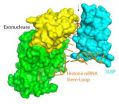(Press-News.org) Washington, D.C.— Researchers still have much to learn about the volcanism that shaped our planet's early history. New evidence from a team led by Carnegie's Frances Jenner demonstrates that some of the tectonic processes driving volcanic activity, such as those taking place today, were occurring as early as 3.8 billion years ago. Their work is published in Geology.
Upwelling and melting of the Earth's mantle at mid-ocean ridges, as well as the eruption of new magmas on the seafloor, drive the continual production of the oceanic crust. As the oceanic crust moves away from the mid-ocean ridges and cools it becomes denser than the underlying mantle. Over time the majority of this oceanic crust sinks back into the mantle, which can trigger further volcanic eruptions. This process is known as subduction and it takes place at plate boundaries.
Volcanic eruptions that are triggered by subduction of oceanic crust are chemically distinct from those erupting at mid-ocean ridges and oceanic island chains, such as Hawaii. The differences between the chemistry of magmas produced at each of these tectonic settings provide 'geochemical fingerprints' that can be used to try to identify the types of tectonic activity taking place early in the Earth's history.
Previous geochemical studies have used similarities between modern subduction zone magmas and those erupted about 3.8 billion years ago, during the Eoarchean era, to argue that subduction-style tectonic activity was taking place early in the Earth's history. But no one was able to locate any suites of volcanic rocks with compositions comparable to modern mid-ocean ridge or oceanic island magmas that were older than 3 billion years and were also free from contamination by continental crust.
Because of this missing piece of the puzzle, it has been ambiguous whether the subduction-like compositions of volcanic rocks erupted 3.8 billion years ago really were generated at subduction zones, or whether this magmatism should be attributed to other processes taking place early in the Earth's history. Consequently, evidence for subduction-related tectonics earlier than 3 billion years ago has been highly debated in scientific literature.
Jenner and her team collected 3.8 billion-year-old volcanic rocks from Innersuartuut, an island in southwest Greenland, and found the samples have compositions comparable to modern oceanic islands, such as Hawaii.
"The Innersuartuut samples may represent the world's oldest recognized suite of oceanic island basalts, free from contamination by continental crust", Jenner said. "This evidence strengthens previous arguments that subduction of oceanic crust into the mantle has been taking place since at least 3.8 billion years ago."
###The authors acknowledge support from an Australian International Postgraduate Research Scholarship, a Ringwood Scholarship, an ARC Discovery grant, and a NERC grant.
The Carnegie Institution for Science (carnegiescience.edu) is a private, nonprofit organization headquartered in Washington, D.C., with six research departments throughout the U.S. Since its founding in 1902, the Carnegie Institution has been a pioneering force in basic scientific research. Carnegie scientists are leaders in plant biology, developmental biology, astronomy, materials science, global ecology, and Earth and planetary science.
Studying ancient Earth's geochemistry
2013-01-18
ELSE PRESS RELEASES FROM THIS DATE:
Wild animals may contribute to the resurgence of African sleeping sickness
2013-01-18
Wild animals may be a key contributor to the continuing spread of African sleeping sickness, new research published in PLOS Computational Biology shows. The West African form of the disease, also known as Gambiense Human African trypanosomiasis, affects around 10,000 people in Africa every year and is deadly if left untreated.
The disease is caused by a brain-invading parasite transmitted by bites of the tsetse fly, and gets its name from the hallmark symptoms of drowsiness and altered sleeping patterns that affect late-stage patients, along with other physical and neurological ...
Factors linked with survival differences between Black, White kidney failure patients
2013-01-18
Highlights
Residence in areas with higher average household income was linked with improved survival in kidney failure patients.
In White patients, income inequality was associated with mortality.
In Black patients exclusively, residence in highly segregated areas was associated with increased mortality.
More than 590,000 Americans in 2010 were treated for kidney failure.
Washington, DC (January 17, 2013) — Complex socioeconomic and residential factors may account for differences in survival between Black and White kidney failure patients, according to a study ...
Climate events drive a high-arctic vertebrate community into synchrony
2013-01-18
Climate change is known to affect the population dynamics of single species, such as reindeer or caribou, but the effect of climate at the community level has been much more difficult to document. Now, a group of Norwegian scientists has found that extreme climate events cause synchronized population fluctuations among all vertebrate species in a relatively simple high arctic community. These findings may be a bellwether of the radical changes in ecosystem stability that could result from anticipated future increases in extreme events. The findings are published in the ...
Scientists expose new vulnerabilities in the security of personal genetic information
2013-01-18
CAMBRIDGE, Mass. (January 17, 2013) – Using only a computer, an Internet connection, and publicly accessible online resources, a team of Whitehead Institute researchers has been able to identify nearly 50 individuals who had submitted personal genetic material as participants in genomic studies.
Intent on conducting an exercise in “vulnerability research”—a common practice in the field of information security—the team took a multi-step approach to prove that under certain circumstances, the full names and identities of genomic research participants can be determined, ...
Mouse research links adolescent stress and severe adult mental illness
2013-01-18
Working with mice, Johns Hopkins researchers have established a link between elevated levels of a stress hormone in adolescence — a critical time for brain development — and genetic changes that, in young adulthood, cause severe mental illness in those predisposed to it.
The findings, reported in the journal Science, could have wide-reaching implications in both the prevention and treatment of schizophrenia, severe depression and other mental illnesses.
"We have discovered a mechanism for how environmental factors, such as stress hormones, can affect the brain's physiology ...
Feed a cold, starve a fever…. and your worms!
2013-01-18
Contact:Gina Alvino
(415) 568-3173
plospathogens@plos.org
Disclaimer
This press release refers to an upcoming article in PLOS Pathogens. The release is provided by the article authors. Any opinions expressed in these releases or articles are the personal views of the journal staff and/or article contributors, and do not necessarily represent the views or policies of PLOS. PLOS expressly disclaims any and all warranties and liability in connection with the information found in the releases and articles and your use of such information.
Media Permissions
PLOS Journals ...
How the brain copes with multi tasking alters with age
2013-01-18
The pattern of blood flow in the prefrontal cortex in the brains alters with age during multi-tasking, finds a new study in BioMed Central's open access journal BMC Neuroscience. Increased blood volume, measured using oxygenated haemoglobin (Oxy-Hb) increased at the start of multitasking in all age groups. But to perform the same tasks, healthy older people had a higher and more sustained increase in Oxy-Hb than younger people.
Age related changes to the brain occur earliest in the prefrontal cortex, the area of the brain associated with memory, emotion, and higher decision ...
It's a dog's life: Doggy database aims to define pet health
2013-01-18
Using data collected about Labrador Retrievers, research published in BioMed Central's open access journal BMC Veterinary Research is beginning to quantify the health, illnesses, and veterinary care of dogs.
The UK is a nation of pet lovers – but what do we know about the health of our pets? To date the long term (longitudinal) study of canine diseases has been patchy, relying on information from referral centers and details about pet illnesses which are not reported to a vet have never been studied before.
The Dogslife internet-based project was organized in conjunction ...
Savanna study highlights African fuelwood crisis
2013-01-18
The dwindling reserves of fuelwood in Africa have been illuminated in a new study published today, which shows a bleak outlook for supplies across savannas in South Africa.
Presenting their findings in IOP Publishing's journal Environmental Research Letters, researchers have found that at current consumption levels in the communal areas of Lowveld, South Africa, reserves of fuelwood could be totally exhausted within 13 years.
The consequences are significant, with around half of the 2.4 million rural households in the country using wood as their primary fuel source, ...
Molecular twist helps regulate the cellular message to make histone proteins
2013-01-18
(Embargoed) CHAPEL HILL, N.C. – Histone proteins are the proteins that package DNA into chromosomes. Every time the cell replicates its DNA it must make large amounts of newly made histones to organize DNA within the nucleus.
An imbalance in the production of DNA and histones is usually lethal for the cell, which is why the levels of the messenger RNA (mRNA) encoding the histone proteins must be tightly controlled to ensure the proper amounts of histones (not too many and not too few) are made.
In a collaborative effort published online in the January 18, 2013 issue ...

